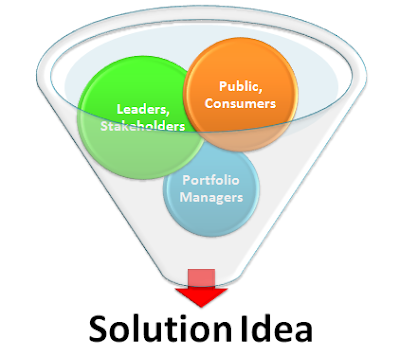Solution Ideation is important in creating long term value because ideas are aligned to business problems as defined by solicited sources.
The Solutionist starts with an idea (concrete or abstract) which becomes the key message and should include key benefits, important for communicating the need for a solution.
Idea Solicitation
There is an emerging trend to solicit ideas from the public, consumers, social networks, and other large populations in addition to traditional methods of getting ideas from leadership, stakeholders, and portfolio managers.
Idea Generation
Ideas are generated based on a prioritization scheme. Sometimes a broad base such as customers, consumers, and end users are asked to suggest and votes on ideas, assuming ideas with broad appeal are good. Traditionally ideas are generated using a variety of methods:
- SWOT (strength, weaknesses, opportunities, threats)
- Mandates, such as legal or contractual requirements
- Business Goals that "cascade" or breakdown into specific solution ideas
- Engineering/Business Fit (benefits, probability of adopton)
- Cost
- Time
Idea Design
If an idea looks good and looks feasible, it can be designed at a high level. This is not to be confused as a technical schematic, but rather a visionary "story board" of what the solution would provide. Often a Business Case document is completed to describe the idea and to demonstrate its potential value.
- Concept, Story board, Prototype
- Business Benefits
- Financials including return on investment (ROI)
- Estimate to Complete
- Integrations and Dependencies
- Risks
- Alternatives
Communicating Ideas
This is typically the most cumbersome step. Many a great idea goes nowhere because its champions don't communicate the idea in to the right people with the right information. Ideas that are good, have a high level design, and a compelling business case also need:
- Champion - person or team who believes in the idea and has the positional and referent authority to influence the decision-makers to approve the idea.
- Communication plan - clear messages, meetings, schedules, conversations to ensure champions, decision makers, and stakeholders understand the idea
- Business discipline - leadership support of the ideation and decision making processes







hello!! Very interesting discussion glad that I came across such informative post. Keep up the good work friend. Glad to be part of your net community.
ReplyDeleteTechnology